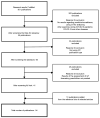Forecasting and Surveillance of COVID-19 Spread Using Google Trends: Literature Review
- PMID: 36231693
- PMCID: PMC9566212
- DOI: 10.3390/ijerph191912394
Forecasting and Surveillance of COVID-19 Spread Using Google Trends: Literature Review
Abstract
The probability of future Coronavirus Disease (COVID)-19 waves remains high, thus COVID-19 surveillance and forecasting remains important. Online search engines harvest vast amounts of data from the general population in real time and make these data publicly accessible via such tools as Google Trends (GT). Therefore, the aim of this study was to review the literature about possible use of GT for COVID-19 surveillance and prediction of its outbreaks. We collected and reviewed articles about the possible use of GT for COVID-19 surveillance published in the first 2 years of the pandemic. We resulted in 54 publications that were used in this review. The majority of the studies (83.3%) included in this review showed positive results of the possible use of GT for forecasting COVID-19 outbreaks. Most of the studies were performed in English-speaking countries (61.1%). The most frequently used keyword was "coronavirus" (53.7%), followed by "COVID-19" (31.5%) and "COVID" (20.4%). Many authors have made analyses in multiple countries (46.3%) and obtained the same results for the majority of them, thus showing the robustness of the chosen methods. Various methods including long short-term memory (3.7%), random forest regression (3.7%), Adaboost algorithm (1.9%), autoregressive integrated moving average, neural network autoregression (1.9%), and vector error correction modeling (1.9%) were used for the analysis. It was seen that most of the publications with positive results (72.2%) were using data from the first wave of the COVID-19 pandemic. Later, the search volumes reduced even though the incidence peaked. In most countries, the use of GT data showed to be beneficial for forecasting and surveillance of COVID-19 spread.
Keywords: COVID-19; Google Trends; forecasting; surveillance.
Conflict of interest statement
The authors declare no conflict of interest.
Figures
Similar articles
-
Forecasting the COVID-19 Epidemic by Integrating Symptom Search Behavior Into Predictive Models: Infoveillance Study.J Med Internet Res. 2021 Aug 11;23(8):e28876. doi: 10.2196/28876. J Med Internet Res. 2021. PMID: 34156966 Free PMC article.
-
Correlations of Online Search Engine Trends With Coronavirus Disease (COVID-19) Incidence: Infodemiology Study.JMIR Public Health Surveill. 2020 May 21;6(2):e19702. doi: 10.2196/19702. JMIR Public Health Surveill. 2020. PMID: 32401211 Free PMC article.
-
Enhancing the Predictive Power of Google Trends Data Through Network Analysis: Infodemiology Study of COVID-19.JMIR Public Health Surveill. 2023 Sep 7;9:e42446. doi: 10.2196/42446. JMIR Public Health Surveill. 2023. PMID: 37676701 Free PMC article.
-
Predictive Models for Forecasting Public Health Scenarios: Practical Experiences Applied during the First Wave of the COVID-19 Pandemic.Int J Environ Res Public Health. 2022 May 3;19(9):5546. doi: 10.3390/ijerph19095546. Int J Environ Res Public Health. 2022. PMID: 35564940 Free PMC article.
-
Google Trends as a predictive tool in the era of COVID-19: a scoping review.Postgrad Med J. 2023 Aug 22;99(1175):962-975. doi: 10.1093/postmj/qgad012. Postgrad Med J. 2023. PMID: 36892422
Cited by
-
Monitoring SARS-CoV-2 Using Infoveillance, National Reporting Data, and Wastewater in Wales, United Kingdom: Mixed Methods Study.JMIR Infodemiology. 2023 Nov 23;3:e43891. doi: 10.2196/43891. JMIR Infodemiology. 2023. PMID: 37903300 Free PMC article.
-
Impact of Demographic and Clinical Subgroups in Google Trends Data: Infodemiology Case Study on Asthma Hospitalizations.J Med Internet Res. 2025 Mar 10;27:e51804. doi: 10.2196/51804. J Med Internet Res. 2025. PMID: 40063932 Free PMC article.
-
Analyzing Online Search Trends for Kidney, Prostate, and Bladder Cancers in China: Infodemiology Study Using Baidu Search Data (2011-2023).JMIR Cancer. 2025 Mar 14;11:e57414. doi: 10.2196/57414. JMIR Cancer. 2025. PMID: 40085845 Free PMC article.
-
Construction and validation of a COVID-19 pandemic trend forecast model based on Google Trends data for smell and taste loss.Front Public Health. 2022 Dec 1;10:1025658. doi: 10.3389/fpubh.2022.1025658. eCollection 2022. Front Public Health. 2022. PMID: 36530657 Free PMC article.
-
Public interest trends for COVID-19 and pandemic trajectory: A time-series analysis of US state-level data.PLOS Digit Health. 2024 Mar 12;3(3):e0000462. doi: 10.1371/journal.pdig.0000462. eCollection 2024 Mar. PLOS Digit Health. 2024. PMID: 38471136 Free PMC article.
References
-
- WHO Coronavirus. [(accessed on 6 July 2021)]. Available online: https://www.who.int/health-topics/coronavirus#tab=tab_1.
-
- Tang D., Tou J., Wang J., Chen Q., Wang W., Huang J., Zhao H., Wei J., Xu Z., Zhao D., et al. Prevention and Control Strategies for Emergency, Limited-Term, and Elective Operations in Pediatric Surgery during the Epidemic Period of COVID-19. World J. Pediatr. Surg. 2020;3:e000122. doi: 10.1136/wjps-2020-000122. - DOI - PMC - PubMed
Publication types
MeSH terms
LinkOut - more resources
Full Text Sources
Medical
Miscellaneous


